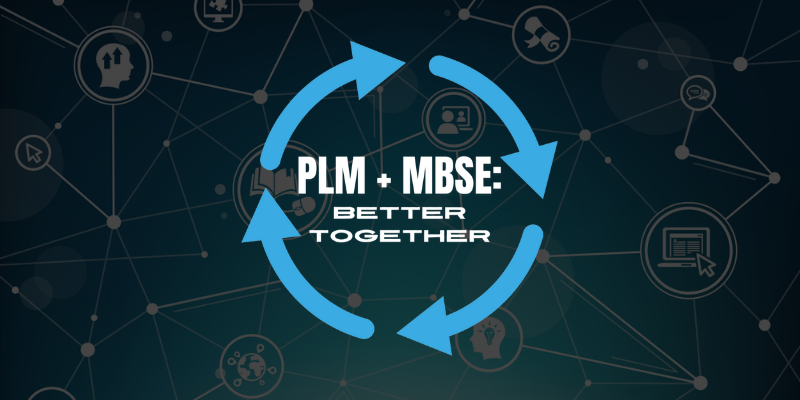SPEC Innovations’ Tool, Innoslate, Joins Iron Bank
Manassas, VA; 04-13-2022: SPEC Innovations is proud to announce that our product, Innoslate, has been accepted into the DoD’s Platform One Iron Bank!...

Don't feel like reading? Watch the webinar recording instead!
In today's ever-evolving technological landscape, the integration of Product Lifecycle Management (PLM) and Model-Based Systems Engineering (MBSE) has become essential for organizations aiming to enhance their product development processes. By combining these two powerful methodologies, companies can achieve a more streamlined approach to managing the complexities of product lifecycles, from conception to disposal.
Product Lifecycle Management (PLM) is a comprehensive approach that encompasses the management of a product's lifecycle from inception through engineering design and manufacturing to service and disposal. PLM integrates people, processes, and technology to facilitate the efficient management of product data and workflows.
It combines five distinct disciplines: systems engineering, program management, product design, process management, and product data management. Each of these areas plays a crucial role in ensuring that products are developed efficiently and meet customer expectations.
On the other hand, Model-Based Systems Engineering (MBSE) focuses on the use of models to support the systems engineering process. It emphasizes the importance of visualizing and analyzing system requirements, design, and behavior through models rather than traditional document-centric approaches.
MBSE enhances communication among stakeholders and provides a clearer understanding of complex systems, ultimately leading to better decision-making.
Related Page: Ultimate Guide to MBSE
When PLM and MBSE are integrated, organizations can leverage the strengths of both methodologies to improve their product development processes. Here are some key benefits of this integration:
Holistic Lifecycle Management: By combining PLM's comprehensive lifecycle management capabilities with MBSE's modeling techniques, organizations can ensure that every aspect of the product lifecycle is considered. This includes not only the design and manufacturing phases but also the operational and disposal stages, which are often overlooked.
Enhanced Collaboration: The integration fosters better collaboration among cross-functional teams. With MBSE providing a common modeling language, stakeholders from different disciplines can communicate more effectively, reducing misunderstandings and aligning their efforts toward common goals.
Improved Requirements Management: Effective requirements management is critical for successful product development. MBSE allows for the rigorous analysis and tracking of requirements, while PLM ensures that these requirements are integrated into the overall product development process. This synergy helps in maintaining traceability and accountability throughout the lifecycle.
Increased Agility: In a rapidly changing market, organizations must be agile in their product development processes. The combination of PLM and MBSE enables teams to respond quickly to changes in customer needs or market conditions, facilitating faster iterations and adaptations.
Risk Mitigation: By utilizing models to simulate and analyze potential issues early in the development process, organizations can identify and mitigate risks before they escalate. This proactive approach leads to higher-quality products and reduced costs associated with late-stage changes.
Innoslate, a comprehensive systems engineering and program management tool, is a key player in bridging the gap between PLM and MBSE. It provides a robust environment that supports the entire lifecycle of product development, seamlessly integrating the principles of PLM and MBSE.
With Innoslate, organizations can manage requirements, design, and test processes all within a single platform. Its modeling capabilities allow teams to visualize complex systems and their interactions, ensuring that all stakeholders have a clear understanding of the project. Additionally, Innoslate's focus on traceability and change management enhances the ability to adapt to evolving requirements and market conditions, making it an invaluable asset for organizations looking to implement PLM and MBSE effectively.
Innoslate also facilitates communication through its intuitive dashboards and document views, allowing teams to access critical information quickly and efficiently. This level of integration not only streamlines workflows but also enhances collaboration across disciplines, ensuring that everyone is aligned and working towards common objectives.
The integration of PLM and MBSE represents a significant advancement in how organizations manage their product development processes. By embracing both methodologies, companies can achieve a more cohesive and efficient approach to lifecycle management, ultimately leading to better products and increased customer satisfaction. As we continue to navigate the complexities of modern engineering and product development, the synergy of PLM and MBSE, supported by tools like Innoslate, will play a pivotal role in driving innovation and success.
PLM and MBSE are not just complementary; they are better together. By harnessing the strengths of both, along with the capabilities of Innoslate, organizations can create a framework that supports the entire product lifecycle, ensuring that they remain competitive.
Learn more advanced model-based systems engineering techniques.
Watch the webinar below.⬇️
Have questions about model-based systems engineering or requirements management? Talk to an expert and see how Innoslate can streamline your projects from start to finish.
%20(4).png)
Manassas, VA; 04-13-2022: SPEC Innovations is proud to announce that our product, Innoslate, has been accepted into the DoD’s Platform One Iron Bank!...

Not up for the read? Watch the recording of the webinar!

1 min read
"Getting Started with Model-Based Systems Engineering" ~ A Webinar for MBSE Beginners. Watch the Recording In today's fast-paced world of systems...